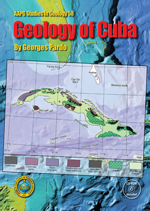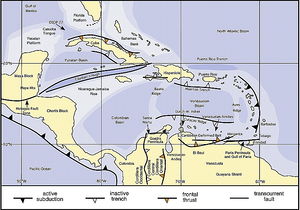Cuba: Geology and regional setting
| Geology of Cuba | |

| |
| Series | Studies in Geology |
|---|---|
| Author | Georges Pardo |
| Link | Web page |
| Store | AAPG Store |

The geology of Cuba has been a challenge to geologists because of features such as the presence of well-preserved Jurassic ammonites, the rich Tertiary foraminiferal faunas (including remarkable Paleogene orbitoids), the gigantic Upper Cretaceous rudistids, the spectacular limestone Mogotes of Pinar del Rio, the extensive outcrops of ultrabasic igneous rocks, the chromite and manganese deposits, and the extraordinary structural complexity. In addition to these features, the numerous petroleum seeps, many of them coming out of basic igneous rock, have attracted much attention.

Regional setting
Cuba is the largest of the Caribbean islands and has an arclike shape, concave to the south (Figure 1). This shape has tempted some authors to call Cuba an island arc. The truth is much more complex. The broad and deep Strats of Florida separate Cuba from Florida, and the narrow, and relatively shallow, Nicholas and Old Bahamas channels separate Cuba from the Bahamas. To the northwest, Cuba adjoins the Gulf of Mexico and is separated from the Yucatan Platform by the narrow but deep Yucatan Channel. To the south, the Yucatan Basin appears to be enclosed between Cuba to the north and the Cayman Ridge, which is the westward continuation of the Sierra Madre in the southern Oriente province. Cuba, the Cayman Basin, and the Cayman Ridge appear to constitute a physiographic province between the stable margin of the North American craton and the highly mobile Caribbean Basin. This province is separated from the Chortis-Nicaraguan rise block, including Jamaica and Hispaniola, by the east to west pull-apart basin of the Cayman trough, whose spreading center has been recording the eastward migration of the Caribbean plate since the late Eocene.
References
- ↑ Pardo, Georges, 2009, The geology of Cuba: AAPG Studies in Geology 58, 73 p.